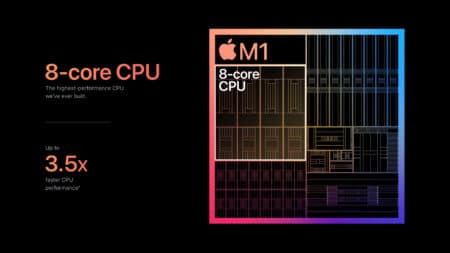Apple unveiled this week a totally redesigned iMac in a 24-inch version with a stunning new thin design. The new machine is powered by Apple’s own chip, the M1. Readers may be wondering if these machines are powerful enough for good performing CAD and 3D work. Below we provide some detailed answers.
M1 iMacs
Let’s put all other aspects of the new iMacs aside for a moment and simply concentrate on the performance of the M1 chip with regards to CPU and GPU (graphics) performance. Recently we published an in-depth feature here on Architosh. (see, Architosh: “The M1 Mac mini vs iMac Pro 2017 vs Everyone (Part 1),” 12 April 2021). That article dives deep but let’s summarize some key items below.
All About Single-Core
Most CAD and 3D modeling software are “single-threaded” and not optimized for the utilization of multiple cores on chips. This fundamentally has to do with the mathematical realities that make 2/3D CAD software work. We’ve had recent conversations in the last year with the folks at Siemens Parasolid, for example, talking about their market-leading modeling kernel, and how much of it can be optimized for multi-threaded processing taking advantage of more CPU cores. The short answer is some parts—but of a limited nature—can be optimized for parallel processing (multithreaded) performance improvements.

Apple’s new 24-in iMac is powered by Apple’s new M1 chip, offering market-leading single-core processing and upper-midrange GPU Performance. (Image: Apple)
So whether one is talking about Revit models, SolidWorks models, or SketchUp models, the driver of performance in modeling activity workflows is primarily the single-core performance of the CPU in combination with the GPU’s performance to redraw the screen. And in this regard, we are talking about the M1’s high-performance Firestorm core(s).
Geekbench 5
When it comes to the Apple M1 chip, the Geekbench 5 scores we have achieved and those others reported are at the top of the industry. No Intel chip matches the M1 in single-core (SC) performance and only AMD’s 5000 series (Zen 3) chips are close. In our tests, we achieved a Geekbench 5 single-core test score of 1748 compared to the 1251 reference score for a 2020 27-in. iMac i7. In our scores on our own iMac Pro (2017 model) with a Xeon processor, the result was 1100, far off the M1’s performance.

Apple’s new M1 Macs absolutely crush the Intel competition, especially on a performance-per-watts basis, enabling Apple to deliver a stunningly thin new iMac enclosure. The M1 is now in the new iPad Pro and that tells us a bit about how Apple aims to economize chip development and place chips into similar TDP enclosure criteria regardless of product line, thus iPad OS and macOS while different are tapping the same chip.
And although we found excellent material online from Nuvia—the chip company started by Gerald Williams, Apple’s former chief CPU architect, about how well Geekbench 5 accurately simulates not just PC workloads but server CPU loads of a “comprehensive general nature”—even they state that an ideal benchmark is one “that is most representative of the customer’s workload.” Therefore, it is good to test against a range of most representative benchmarks. That is why we tested with GFXbench and Cinebench as well. In the latter, the M1 essentially tied a top reference score (Intel i7 11th Gen) 4-core machine. (see image here). When you get a moment read our two-part feature as it goes deep into the M1’s performance.



Reader Comments
Readers interested in the Apple M1 should note our stories on the M1 Pro and M1 Max chip now inside the new late 2021 MacBook Pros. see: “Thoughts on Apple’s M1 Pro, Max and MacBook Pros.” — https://architosh.com/2021/10/thoughts-on-apples-m1-pro-max-and-macbook-pros/
I think you should also point out the difficulty running Windows on M1 Macs and therefore the limitiation to software available for Mac OS. As someone who has taught a range of CAD/3D software for many years I’ve found this is a dealbreaker, since much of this software is PC only
Denny, Corel’s latest Parallels supports the new M-series chips by Apple. That product looks really solid and we plan to test it in the new year ahead once we get our hands on a new iMac 27 with M1 Max chip or whatever Apple puts in the new machine.
What software platforms do you happen to teach, Denny?
Comments are closed.